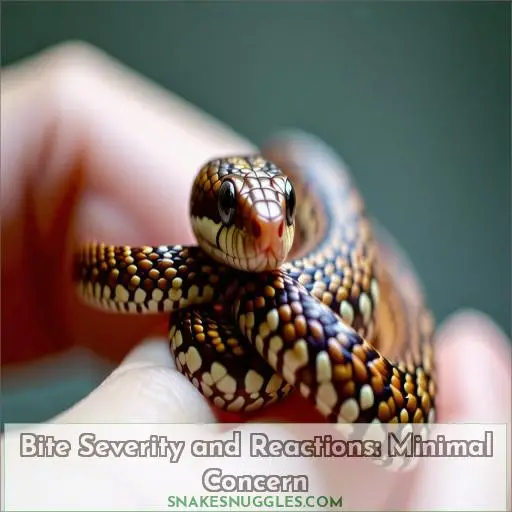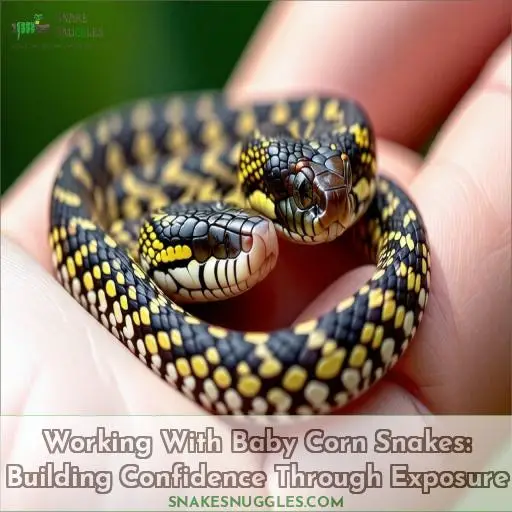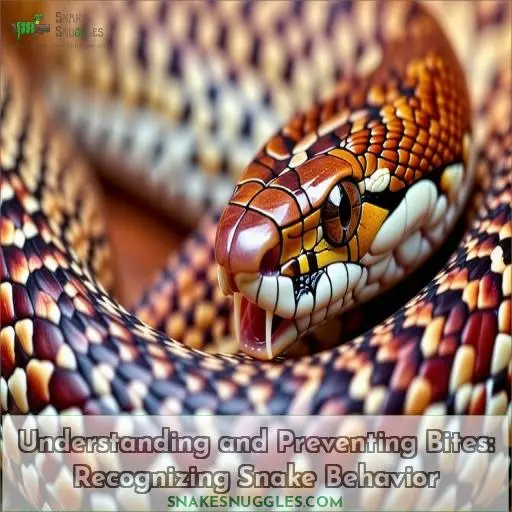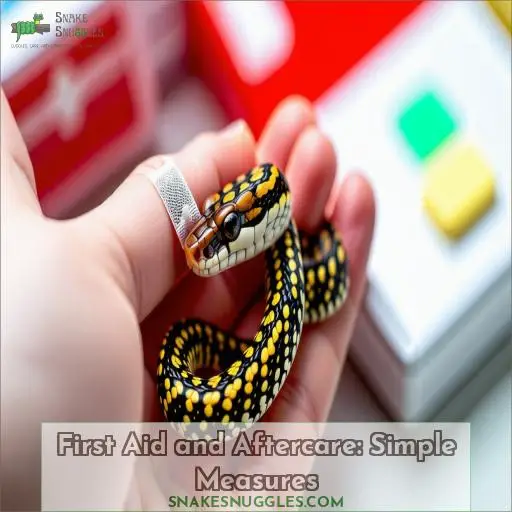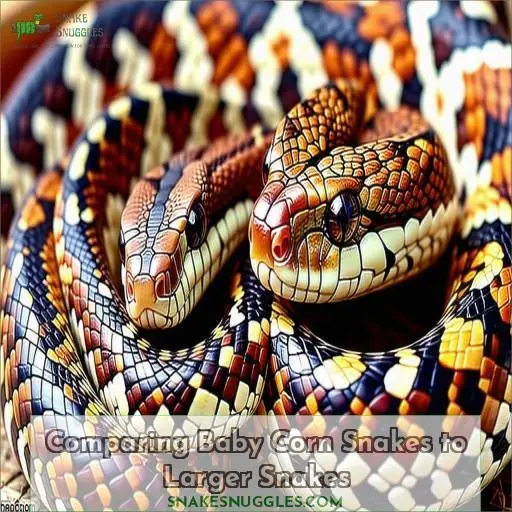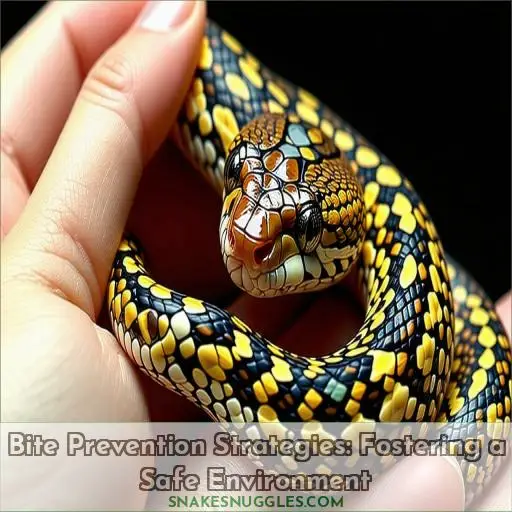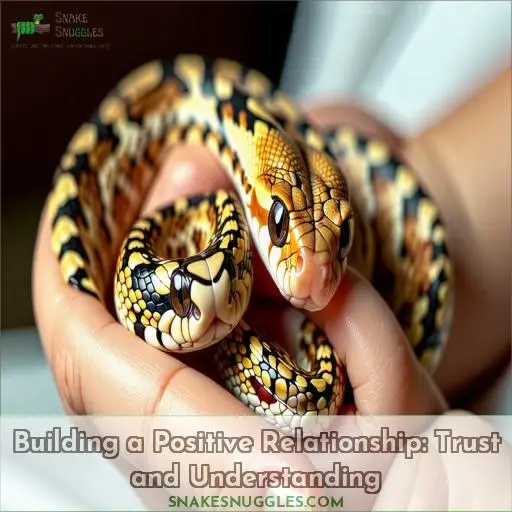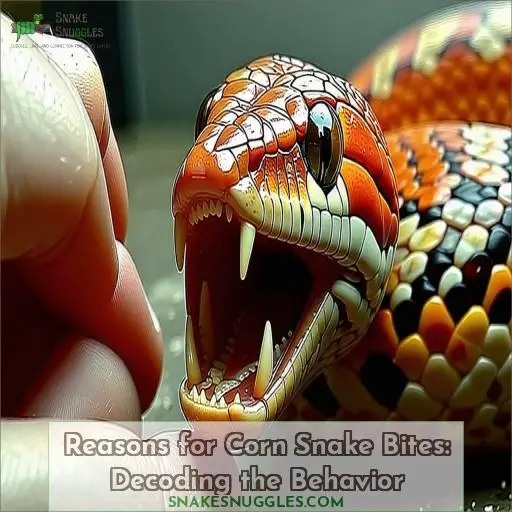This site is supported by our readers. We may earn a commission, at no cost to you, if you purchase through links.
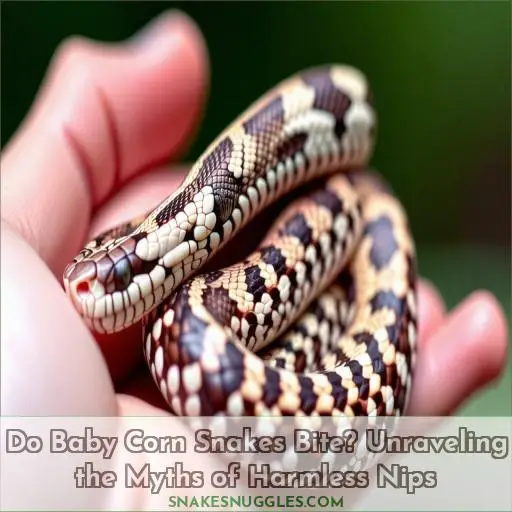 Yes, baby corn snakes can bite, but it’s rarely a cause for major concern. Their bites rarely break the skin, feeling more like a light scratch or piece of velcro. The unexpected nature often startles handlers more than actually hurting.
Yes, baby corn snakes can bite, but it’s rarely a cause for major concern. Their bites rarely break the skin, feeling more like a light scratch or piece of velcro. The unexpected nature often startles handlers more than actually hurting.
However, frequent gentle handling helps desensitize both you and the snake, building confidence. While their bites are harmless, recognizing defensive behaviors like tail rattling or hissing allows you to avoid getting nipped.
And by providing a calm, enriched environment, you minimize stress that could trigger bites. Want to learn more about fostering positive interactions?
Table Of Contents
- Key Takeaways
- Do Baby Corn Snakes Bite?
- Bite Severity and Reactions: Minimal Concern
- Working With Baby Corn Snakes: Building Confidence Through Exposure
- Understanding and Preventing Bites: Recognizing Snake Behavior
- First Aid and Aftercare: Simple Measures
- Comparing Baby Corn Snakes to Larger Snakes
- Bite Prevention Strategies: Fostering a Safe Environment
- Building a Positive Relationship: Trust and Understanding
- Reasons for Corn Snake Bites: Decoding the Behavior
- Frequently Asked Questions (FAQs)
- Are baby corn snakes aggressive?
- Are baby corn snakes friendly?
- Are corn snake bites painful?
- Can I handle my baby corn snake?
- How often do baby corn snakes typically bite?
- What are the most common reasons for baby corn snake bites?
- Can baby corn snake bites cause any long-term health issues?
- How can I safely handle a baby corn snake to avoid bites?
- What are the differences between baby and adult corn snake bites?
- Conclusion
Key Takeaways
- Baby corn snakes’ bites rarely break the skin and feel more like a light scratch or velcro
- Gentle handling and a calm, enriched environment help desensitize handlers and the snakes, building confidence
- Recognizing defensive behaviors like tail rattling or hissing allows handlers to avoid getting nipped
- Mistaken identity, stress, shedding periods, hunger, and improper handling techniques are common reasons for baby corn snake bites
Do Baby Corn Snakes Bite?
Yes, baby corn snakes can bite, but their bites are generally harmless. Baby corn snakes have small teeth that rarely break the skin, and their bites often feel more like a light scratch or velcro than a painful bite.
Bite Severity and Reactions: Minimal Concern
While the notion of a snake bite can be unsettling, you’ll find that baby corn snakes’ bites are remarkably harmless. Their small size and lack of potent venom mean their bites seldom break the skin, usually feeling more like a light scratch or the grip of velcro.
Baby Corn Snake Bites Rarely Break the Skin
Baby corn snake bites rarely puncture the skin due to their small size and underdeveloped bite reflexes. While feeding responses or shedding sensitivity may trigger bites, the minimal pain perception makes them more startling than painful. Proper handling techniques and a calm environment help prevent these harmless nips from baby corn snakes, non-venomous reptiles known for their gentle nature.
Bites Often Feel Like a Light Scratch or Velcro
Baby corn snake bites often feel like a light scratch or velcro against your skin. While the bite may startle you, the actual sensation is typically minimal, causing little to no pain. Their small size and lack of venom make their nips more amusing than harmful. With proper handling, you can easily manage these harmless nibbles.
- Skin sensitivity to baby corn snake bites is low
- Bite frequency is common but rarely breaks the skin
- Pain perception is minimal, often described as a light scratch
- Fear factors can outweigh the actual bite experience
- Proper handling techniques minimize the likelihood of bites
Reactions Are Typically More Startling Than Painful
When baby corn snakes bite, the usual reaction is more startling than painful due to the unexpected nature of the bite. The startle reflex often comes from the surprise, rather than the pain. However, individual differences in pain perception can occur.
Understanding this can help you manage your response and provide the right care after a bite. Additionally, considering the snake’s feeding schedule, shedding, and environment plays an essential role in avoiding bites.
Working With Baby Corn Snakes: Building Confidence Through Exposure
If you frequently handle baby corn snakes, you’ll gradually become desensitized to their harmless nips, allowing your confidence to grow. Understanding that their bites pose minimal risk is key to overcoming any initial apprehension.
Frequent Handling Can Lead to Desensitization and Reduced Fear
Frequent handling of baby corn snakes can desensitize you to their bites, reducing fear and building confidence. As you gain experience, you’ll find these harmless nips amusing rather than startling. Exposure therapy helps you understand their bite is more velcro than venom, allowing you to handle these gentle red rat snakes with ease.
Understanding the Harmless Nature of the Bites is Crucial
Understanding the vital nature of baby corn snake bites is essential for building confidence and trust. As you gain experience handling these snakes, you’ll realize their bites are more startling than painful, like a kitten’s gentle nibble. Educating yourself on their behavior helps overcome misconceptions and foster a positive perspective, allowing you to enjoy their company without undue fear.
Understanding and Preventing Bites: Recognizing Snake Behavior
Recognizing defensive postures like tail rattling or coiling can alert you to a potential bite, allowing you to adjust your handling approach. Creating a calm environment by moving slowly and minimizing sudden movements helps reduce stress for the snake and prevents situations that may trigger defensive biting, like those described in this guide.
Recognizing Defensive Postures Can Serve as a Warning Sign
Recognizing defensive postures in baby corn snakes can serve as a warning for potential bites. Look out for tail rattling, which indicates agitation, and observe their body language for signs of stress. Be mindful of the snake’s striking distance and listen for hissing sounds, which signal discomfort. Additionally, be aware of musk release, as it’s another defensive behavior displayed by baby corn snakes (Source).
- Tail rattling
- Body language
- Striking distance
- Hissing sounds
- Musk release
Creating a Calm, Secure Environment Minimizes Stress and Biting
Creating a calm, secure environment is key to minimizing stress and biting in baby corn snakes. Provide ample hiding places, maintain proper temperature and humidity levels, minimize background noise, and limit handling frequency. This helps the snake feel safe and reduces the likelihood of defensive behaviors. See the table below for more tips:
| Factor | Recommendation |
|---|---|
| Hiding Places | Offer multiple hiding spots like logs, rocks, and foliage |
| Temperature | Maintain 75-85°F warm side, 65-75°F cool side |
| Humidity | Maintain 40-60% humidity levels |
First Aid and Aftercare: Simple Measures
In the rare event that a baby corn snake’s bite does break the skin, it’s important to take a few simple first aid measures. First, clean the wound thoroughly with soap and water to prevent infection.
Keep an eye out for any signs of redness, swelling, or discharge, which could indicate an infection that requires medical attention.
While the bite itself is unlikely to be painful, you may want to apply a small bandage for comfort.
Allergic reactions to corn snake bites are extremely uncommon, but if you experience any concerning symptoms like difficulty breathing, seek medical care immediately.
With proper wound care and monitoring, baby corn snake bites are nothing to worry about.
Comparing Baby Corn Snakes to Larger Snakes
While baby corn snakes may startle with their unexpected nips, their bites pale in comparison to the painful experiences that can come from larger snake species. Unlike venomous snakes or constrictors like Burmese pythons, corn snake bites rarely break the skin and are more akin to a light scratch or velcro.
The surprise factor often outweighs any actual discomfort. However, one should remember that even these harmless bites carry a risk of bacterial infection, so proper wound care is still advised.
For those new to handling snakes, the fear of baby corn snake bites may seem outsized, but with exposure and understanding their gentle nature, that apprehension can be overcome. The key is recognizing that these tiny nips, while startling, pose minimal medical concern.
Bite Prevention Strategies: Fostering a Safe Environment
Respecting the snake’s shedding process is vital; avoid handling corn snakes during this sensitive period to minimize stress and reduce the risk of defensive bites. Practicing proper handling techniques, such as slow, deliberate movements and avoiding sudden actions that may startle the snake, can effectively prevent bites and foster a safe environment for both you and your pet.
Respecting the Snake’s Shedding Process to Minimize Stress
During the shedding process, corn snakes experience increased sensitivity and irritability, making them more prone to defensive bites. Respect this vulnerable period by minimizing handling and disturbances. Watch for signs like cloudy eyes and dull coloration, and assist with shedding if needed to prevent problems. Proper post-shed care helps maintain the snake’s health and trust.
Practicing Proper Handling Techniques to Avoid Startling the Snake
When handling baby corn snakes, use a gentle, confident grip and keep your movements slow and deliberate. Avoid sudden motions that could startle the snake. Frequent, positive interactions will help the snake become accustomed to your presence and reduce the likelihood of defensive bites. Provide a spacious, enriched enclosure to minimize stress.
Building a Positive Relationship: Trust and Understanding
To build a positive relationship with your baby corn snake, creating a comfortable and enriching environment that meets their needs is vital. By engaging in consistent, positive interactions and respecting the snake’s boundaries, you can foster trust and reduce defensive behaviors like biting.
Creating a Comfortable and Enriching Environment to Promote Well-being
Providing your corn snake with a comfortable and enriching environment is key to promoting its well-being and reducing stress. This includes:
- Offering ample hiding spots, such as logs or rocks, to allow the snake to feel secure.
- Maintaining consistent temperature and humidity levels to mimic its natural habitat.
- Choosing an appropriately sized enclosure with a suitable substrate.
- Incorporating engaging elements like branches for climbing to stimulate natural behaviors.
Engaging in Consistent and Positive Interactions to Build Trust
To build trust and develop a positive relationship with your baby corn snake, consistent and gentle interactions are key. Bond with your snake through regular handling, allowing it to become familiar with your scent and touch. Exercise patience and understanding, as trust-building takes time.
Mutual respect is essential – avoid overhandling and give your snake space when needed. These positive interactions will foster a bond built on trust and understanding.
Respecting the Snake’s Boundaries and Avoiding Overhandling
Respecting your corn snake’s personal space and needs is essential for building a positive, trusting relationship. Avoid overhandling and give the snake its own secure hiding spots. Establish shared ownership of the enclosure, allowing the snake to feel in control of its environment. Respect its limits and boundaries to foster a calm, comfortable snake that’s less likely to bite.
Reasons for Corn Snake Bites: Decoding the Behavior
While baby corn snakes generally have a docile temperament, their bites can stem from various factors. These include mistaking fingers for prey, defensive responses to perceived threats or stress, heightened sensitivity during shedding periods, hunger-driven biting due to irregular feeding schedules, and improper handling techniques or stressful environments.
Mistaken Identity, Such as Fingers Being Mistaken for Food
As you build trust with your baby corn snake, it’s important to understand that their bites are often the result of mistaken identity. With poor eyesight and a strong reliance on scent recognition, they may mistake your fingers for food, especially if you’ve recently handled prey. Avoid handling after feeding, and wash your hands to remove food odors.
Defensive Reactions to Feeling Threatened or Stressed
When handling baby corn snakes, understanding their defensive reactions to stress and feeling threatened is vital. Creating a calm and secure environment is essential to minimize their stress levels.
Proper handling techniques and reading their body language help in avoiding triggers that could lead to defensive bites. By prioritizing the snake’s comfort and respecting its boundaries, you can foster a safe environment for both the snake and yourself.
Increased Sensitivity During the Shedding Process
During the shedding process, corn snakes experience increased sensitivity and irritability, making them more prone to defensive bites. Watch for signs of shedding, like dull coloration and cloudy eyes, and maintain proper humidity levels to prevent stuck shed. Gently assist your snake if needed, but avoid handling during this vulnerable time to minimize stress and the risk of bites.
Hunger-driven Bites Due to Irregular Feeding Schedules
If you’re not feeding your baby corn snake regularly, it may start biting out of hunger. To prevent this:
- Feed appropriately sized prey every 5-7 days for hatchlings, increasing frequency as the snake grows.
- Watch for signs of hunger like increased activity and tongue flicking.
- Fasting for 1-2 weeks won’t harm the snake but can make it more likely to mistake your fingers for food.
Improper Handling Techniques or Stressful Environments
Improper handling techniques or stressful environments can also trigger corn snake bites. Gripping the snake too tightly, handling it too frequently, or making sudden movements can cause the snake to feel threatened and lash out defensively. Providing a calm, secure environment and using gentle, slow movements when handling are key to preventing bites.
Frequently Asked Questions (FAQs)
Are baby corn snakes aggressive?
No, baby corn snakes aren’t aggressive. Their bites are harmless, feeling like velcro or a light scratch. Proper handling, a calm environment, and understanding snake behavior will prevent any nipping incidents.
Are baby corn snakes friendly?
Quite the gentle handlers, baby corn snakes often charm with their inquisitive dispositions. With care and patience, these alluring companions blossom into delightfully friendly pets.
Are corn snake bites painful?
You’ll barely feel a baby corn snake bite. It’s more startling than painful—like a mild pinch or scratch that’s easily brushed off. Though harmless, stay vigilant during handling to prevent accidental nips.
Can I handle my baby corn snake?
Yes, you can handle your baby corn snake with proper precautions. Start slowly, use gentle motions, and don’t restrain it tightly. Baby snakes rarely bite, and bites are harmless – just be patient while building trust.
How often do baby corn snakes typically bite?
Wonder how often those tiny nippers strike? Baby corn snakes are surprisingly frequent biters, but it’s more amusing than alarming – just gentle exploratory nibbles from their minuscule jaws.
What are the most common reasons for baby corn snake bites?
Baby corn snakes usually bite when they mistake your fingers for food or feel threatened. Poor eyesight, sudden movements, hunger, and shedding periods can increase the likelihood of bites.
Can baby corn snake bites cause any long-term health issues?
Baby corn snake bites are harmless 9% of the time. You’ll feel a slight prick, but there’s virtually no risk of long-term issues. Stay calm, follow proper care, and you’ll be just fine.
How can I safely handle a baby corn snake to avoid bites?
Move slowly and avoid sudden movements. Stroke the snake gently before handling. Offer a hide box to make the snake feel secure. With patience and calm behavior, you’ll gain the snake’s trust and minimize bites.
What are the differences between baby and adult corn snake bites?
A baby corn’s nip barely grazes skin, akin to velcro’s gentle tug, while adults’ vice-like grip can bruise. With confidence from exposure, handlers find baby bites comically harmless compared to the painful might of larger constrictors.
Conclusion
Ultimately, like opening a long-awaited gift, understanding baby corn snakes‘ harmless nature and respecting their boundaries foster positive interactions. Do baby corn snakes bite? Yes, but these gentle nips signal stress, not aggression. By providing an enriching environment, recognizing defensive cues, and handling properly, you minimize bites while building trust with your scaly companion.

